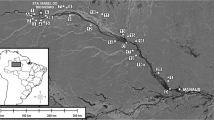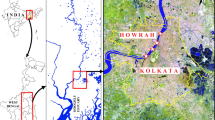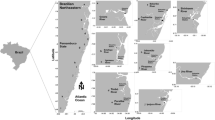Abstract
The quantitative contribution of tropical estuaries to the atmospheric CO2 budget has large uncertainties, both spatially and seasonally. We investigated the seasonal and spatial variations of carbon biogeochemistry downstream of Ho Chi Minh City (Southern Vietnam). We sampled four sites distributed from downstream of a highly urbanised watershed through mangroves to the South China Sea coast during the dry and wet seasons. Measured partial pressure of CO2 (pCO2) ranged from 660 to 3000 μatm during the dry season, and from 740 to 5000 μatm during the wet season. High organic load, dissolved oxygen saturation down to 17%, and pCO2 up to 5000 μatm at the freshwater endmember of the estuary reflected the intense human pressure on this ecosystem. We show that releases from mangrove soils affect the water column pCO2 in this large tropical estuary (~600 m wide and 10–20 m deep). This study is among the few to report direct measurements of both water pCO2 and CO2 emissions in a Southeast Asian tropical estuary located in a highly urbanised watershed. It shows that the contribution of such estuaries may have been previously underestimated, with CO2 emissions ranging from 74 to 876 mmol m−2 day−1 at low current velocity (< 0.2 m s−1). Corresponding gas transfer velocities k600, ranging from 1.7 to 11.0 m day−1, were about 2 to 4 times of k600 estimated using published literature equations.








Similar content being viewed by others
References
Abril G, Commarieu M-V, Sottolichio A et al (2009) Turbidity limits gas exchange in a large macrotidal estuary. Estuar Coast Shelf Sci 83:342–348. https://doi.org/10.1016/j.ecss.2009.03.006
Abril G, Deborde J, Savoye N et al (2013) Export of 13C-depleted dissolved inorganic carbon from a tidal forest bordering the Amazon estuary. Estuar Coast Shelf Sci 129:23–27. https://doi.org/10.1016/j.ecss.2013.06.020
Abril G, Bouillon S, Darchambeau F et al (2015) Technical Note: Large overestimation of pCO2 calculated from pH and alkalinity in acidic, organic-rich freshwaters. Biogeosciences 12:67–78. https://doi.org/10.5194/bg-12-67-2015
Akhand A, Chanda A, Manna S et al (2016) A comparison of CO2 dynamics and air–water fluxes in a river-dominated estuary and a mangrove-dominated marine estuary. Geophys Res Lett. https://doi.org/10.1002/2016GL070716
Alongi DM (2014) Carbon cycling and storage in mangrove forests. Ann Rev Mar Sci 6:195–219. https://doi.org/10.1146/annurev-marine-010213-135020
Amorocho J, DeVries JJ (1980) A new evaluation of the wind stress coefficient over water surfaces. J Geophys Res Ocean 85:433–442. https://doi.org/10.1029/JC085iC01p00433
Atkins ML, Santos IR, Ruiz-Halpern S, Maher DT (2013) Carbon dioxide dynamics driven by groundwater discharge in a coastal floodplain creek. J Hydrol 493:30–42. https://doi.org/10.1016/j.jhydrol.2013.04.008
Benson BB, Krause D (1984) The concentration and isotopic fractionation of oxygen dissolved in freshwater and seawater in equilibrium with the atmosphere. Limnol Oceanogr 29:620–632
Borges AV, Abril G (2011) 5.04-Carbon dioxide and methane dynamics in estuaries. In: Eric W, Donald M (eds) Treatise on estuarine and coastal science. Academic Press, Amsterdam, pp 119–161
Borges AV, Vanderborght J-P, Schiettecatte L-S et al (2004) Variability of the gas transfer velocity of CO2 in a macrotidal estuary (the Scheldt). Estuaries 27:593–603. https://doi.org/10.1007/BF02907647
Bouillon S, Borges AV, Castañeda-Moya E et al (2008) Mangrove production and carbon sinks: a revision of global budget estimates. Global Biogeochem Cycles. https://doi.org/10.1029/2007GB003052
Bouillon S, Connolly RM, Gillikin DP (2011) Use of stable isotopes to understand food webs and ecosystem functioning in estuaries. In: Wolanski E, McLusky DS (eds) Treatise on estuarine and coastal science. Elsevier, Waltham, pp 143–173
Cai W-J (2011) Estuarine and coastal ocean carbon paradox: CO2 sinks or sites of terrestrial carbon incineration? Ann Rev Mar Sci 3:123–145. https://doi.org/10.1146/annurev-marine-120709-142723
Call M, Maher DT, Santos IR et al (2015) Spatial and temporal variability of carbon dioxide and methane fluxes over semi-diurnal and spring–neap–spring timescales in a mangrove creek. Geochim Cosmochim Acta 150:211–225. https://doi.org/10.1016/j.gca.2014.11.023
Chen C-TA, Huang T-H, Chen Y-C et al (2013) Air–sea exchanges of CO2 in the world’s coastal seas. Biogeosciences 10:6509–6544. https://doi.org/10.5194/bg-10-6509-2013
Finlay JC (2003) Controls of streamwater dissolved inorganic carbon dynamics in a forested watershed. Biogeochemistry 62:231–252
Frankignoulle M, Borges A, Biondo R (2001) A new design of equilibrator to monitor carbon dioxide in highly dynamic and turbid environments. Water Res 35:1344–1347. https://doi.org/10.1016/S0043-1354(00)00369-9
Guo X, Cai W-J, Zhai W et al (2008) Seasonal variations in the inorganic carbon system in the Pearl River (Zhujiang) estuary. Cont Shelf Res 28:1424–1434. https://doi.org/10.1016/j.csr.2007.07.011
Ho DT, Schlosser P, Orton PM (2011) On factors controlling air–water gas exchange in a large tidal river. Estuaries Coasts. https://doi.org/10.1007/s12237-011-9396-4
Ho DT, Coffineau N, Hickman B et al (2016) Influence of current velocity and wind speed on air–water gas exchange in a mangrove estuary: gas Exchange in a Mangrove Estuary. Geophys Res Lett 43:3813–3821. https://doi.org/10.1002/2016GL068727
Hofmann EE, Cahill B, Fennel K et al (2011) Modeling the dynamics of continental shelf carbon. Ann Rev Mar Sci 3:93–122. https://doi.org/10.1146/annurev-marine-120709-142740
Huang T-H, Fu Y-H, Pan P-Y, Chen C-TA (2012) Fluvial carbon fluxes in tropical rivers. Curr Opin Environ Sustain 4:162–169. https://doi.org/10.1016/j.cosust.2012.02.004
Koei N (1996) The master plan study on Dong Nai River and surrounding basins water resources development. Final Report. Vol. 9. Appendix VIII. Flood mitigation and urban drainage. Nippon Koei, Tokyo
Koné YJ-M, Borges AV (2008) Dissolved inorganic carbon dynamics in the waters surrounding forested mangroves of the Ca Mau Province (Vietnam). Estuarine Coastal Shelf Sci. https://doi.org/10.1016/j.ecss.2007.10.001
Le TPQ, Dao VN, Rochelle-Newall E et al (2017) Total organic carbon fluxes of the Red River system (Vietnam): TOC fluxes of the Red River. Earth Surf Proc Land. https://doi.org/10.1002/esp.4107
Lee SY (2016) From blue to black: anthropogenic forcing of carbon and nitrogen influx to mangrove-linedestuaries in the South China Sea. Mar Pollut Bull 109:682–690. https://doi.org/10.1016/j.marpolbul.2016.01.008
Leopold A, Marchand C, Deborde J, Allenbach M (2017) Water biogeochemistry of a mangrove-dominated estuary under a semi-arid climate (New Caledonia). Estuaries Coast 40:773. https://doi.org/10.1007/s12237-016-0179-9
Li S, Lu XX, Bush RT (2013) CO2 partial pressure and CO2 emission in the Lower Mekong River. J Hydrol 504:40–56. https://doi.org/10.1016/j.jhydrol.2013.09.024
Lorke A, Bodmer P, Noss C et al (2015) Technical note: drifting versus anchored flux chambers for measuring greenhouse gas emissions from running waters. Biogeosciences 12:7013–7024. https://doi.org/10.5194/bg-12-7013-2015
Maher DT, Santos IR, Golsby-Smith L et al (2013) Groundwater-derived dissolved inorganic and organic carbon exports from a mangrove tidal creek: the missing mangrove carbon sink? Limnol Oceanogr 58:475–488. https://doi.org/10.4319/lo.2013.58.2.0475
Matthews CJD, St.Louis VL, Hesslein RH (2003) Comparison of three techniques used to measure diffusive gas exchange from sheltered aquatic surfaces. Environ Sci Technol 37:772–780. https://doi.org/10.1021/es0205838
Millero FJ (2010) Carbonate constants for estuarine waters. Mar Freshw Res 61:139. https://doi.org/10.1071/MF09254
Millero FJ, Graham TB, Huang F et al (2006) Dissociation constants of carbonic acid in seawater as a function of salinity and temperature. Mar Chem 100:80–94. https://doi.org/10.1016/j.marchem.2005.12.001
Minh NH, Minh TB, Iwata H et al (2007) Persistent organic pollutants in sediments from SaiGon–Dong Nai River basin, vietnam: levels and temporal trends. Arch Environ Contam Toxicol 52:458–465. https://doi.org/10.1007/s00244-006-0157-5
Miyajima T, Tsuboi Y, Tanaka Y, Koike I (2009) Export of inorganic carbon from two Southeast Asian mangrove forests to adjacent estuaries as estimated by the stable isotope composition of dissolved inorganic carbon. J Geophys Res. https://doi.org/10.1029/2008JG000861
Müller D, Warneke T, Rixen T et al (2016) Fate of terrestrial organic carbon and associated CO2 and CO emissions from two Southeast Asian estuaries. Biogeosciences 13:691–705. https://doi.org/10.5194/bg-13-691-2016
Nam VN, Sinh LV, Miyagi T et al (2014) An overview of Can Gio district and mangrove biosphere reserve. In: Miyagi T (ed) Studies in Can Gio mangrove biosphere reserve. Tohoku Gakuin University, Ho Chi Minh City
Park PK (1969) Oceanic CO2 system: an evaluation of ten methods of investigation. Limnol Oceanogr 14:179–186. https://doi.org/10.4319/lo.1969.14.2.0179
R Core Team (2017) R: a language and environment for statistical computing. R Foundation for Statistical Computing, Vienna.URL https://www.R-project.org/
Raymond PA, Cole JJ (2001) Gas exchange in rivers and estuaries: choosing a gas transfer velocity. Estuaries Coast 24:312–317. https://doi.org/10.2307/1352954
Regnier P, Friedlingstein P, Ciais P et al (2013) Anthropogenic perturbation of the carbon fluxes from land to ocean. Nat Geosci 6:597–607. https://doi.org/10.1038/ngeo1830
Ringler C, Cong NC, Huy NV (2002) Water allocation and use in the Dong Nai River basin in the context of water institution strengthening. In: Integrated water-resources management in a River-basin context: institutional strategies for improving the productivity of agricultural water management, p 215
Rosentreter JA, Maher DT, Ho DT, Call M, Barr JG, Eyre BD (2017) Spatial and temporal variability of CO2 and CH4 gas transfer velocities and quantification of the CH4 microbubble flux in mangrove dominated estuaries: gas transfers in estuaries. Limnol Oceanogr 62:561–578. https://doi.org/10.1002/lno.10444
Rosentreter JA, Maher DT, Erler DV et al (2018) Seasonal and temporal CO2 dynamics in three tropical mangrove creeks: a revision of global mangrove CO2 emissions. Geochim Cosmochim Acta. https://doi.org/10.1016/j.gca.2017.11.026
Strady E, Dang VBH, Némery J et al (2017) Baseline seasonal investigation of nutrients and trace metals in surface waters and sediments along the Saigon River basin impacted by the megacity of Ho Chi Minh (Vietnam). Environ Sci Pollut R 24:3226–3243. https://doi.org/10.1007/s11356-016-7660-7
Tuan VQ, Kuenzer C (2012) Can Gio mangrove biosphere reserve evaluation, 2012: current status, dynamics, and ecosystem services. IUCN Viet Nam Country Office, Hanoi
Vachon D, Prairie YT, Cole JJ (2010) The relationship between near-surface turbulence and gas transfer velocity in freshwater systems and its implications for floating chamber measurements of gas exchange. Limnol Oceanogr 55:1723–1732. https://doi.org/10.4319/lo.2010.55.4.1723
Verney R, Lafite R, Brun-Cottan J-C (2009) Flocculation potential of estuarine particles: the importance of environmental factors and of the spatial and seasonal variability of suspended particulate matter. Estuaries Coasts 32:678–693. https://doi.org/10.1007/s12237-009-9160-1
Wanninkhof R (1992) Relationship between wind speed and gas exchange over the ocean. J Geophys Res Oceans 97:7373–7382. https://doi.org/10.1029/92JC00188
Weiss RF (1974) Carbon dioxide in water and seawater: the solubility of a non-ideal gas. Mar Chem 2:203–215. https://doi.org/10.1016/0304-4203(74)90015-2
Yoon TK, Jin H, Oh N-H, Park J-H (2016) Technical note: assessing gas equilibration systems for continuous pCO2 measurements in inland waters. Biogeosciences 13:3915–3930. https://doi.org/10.5194/bg-13-3915-2016
Acknowledgements
The authors would like to thank the Air Liquide Foundation for providing financial support for gas analysers and samplings field trips. The support of the PEPS CNRS-IRD “Mangrove” is also gratefully acknowledged. The salary of F. David was funded by a grant from the Ministère de l’Enseignement Supérieur, de la Recherche et de l’Innovation. Vietnamese students and the Can Gio mangrove management board are gratefully thanked for their help during the field trips. The anonymous reviewers and the associate editor, Stephen D. Sebestyen, greatly improved this ms., and they are gratefully thanked.
Author information
Authors and Affiliations
Corresponding author
Additional information
Responsible Editor: Stephen D. Sebestyen.
Electronic supplementary material
Below is the link to the electronic supplementary material.
Rights and permissions
About this article
Cite this article
David, F., Meziane, T., Tran-Thi, NT. et al. Carbon biogeochemistry and CO2 emissions in a human impacted and mangrove dominated tropical estuary (Can Gio, Vietnam). Biogeochemistry 138, 261–275 (2018). https://doi.org/10.1007/s10533-018-0444-z
Received:
Accepted:
Published:
Issue Date:
DOI: https://doi.org/10.1007/s10533-018-0444-z




